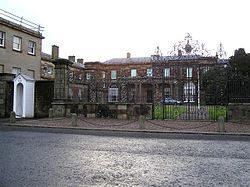Hillsborough Castle
| Hillsborough Castle | |
| County Down | |
|---|---|
 The official entrance of Hillsborough Castle | |
| Location | |
| Location: | 54°27’41"N, 6°5’10"W |
| Village: | Hillsborough |
| History | |
| Information | |
| Owned by: | The Crown |
Hillsborough Castle is a grand country mansion in County Down. Once the palatial residence of the Marquesses of Downshire, it is today in the ownership of the Crown with the status of a royal palace. It serves as the official residence of the Secretary of State for Northern Ireland, and the official residence in Northern Ireland of Her Majesty The Queen.
The Castle provides a residence for The Queen and members of the Royal Family when they visit Ulster, and hosts prominent international visitors. From 1924 until 1973 it was the official residence of the Governor of Northern Ireland.[1] The post of Governor was abolished in 1973.
Origins
Hillsborough Castle stands in the village of Hillsborough in the northwest of County Down. It is not a true castle but a Georgian country house built in the 18th century for the Hill family, Marquesses of Downshire, who owned it until 1922 when the 6th Marquess sold the mansion and its grounds to the government.[1]
In buying the castle, the government solved a practical problem caused by the hurried introduction of dual Home Rule in Ireland, requiring the creation of new governmental structures in a new region, Northern Ireland. The Lord Lieutenant of Ireland, sitting in Dublin had served both Northern and Southern Ireland, but his office was abolished under the Anglo-Irish Treaty of 1921, and a Governor of Northern Ireland was appointed, who needed a viceregal seat. Hillsborough Castle was bought by the Crown to fill that role. After some renovations, the first Governor, the 3rd Duke of Abercorn, moved in during 1925.
Secretary of State
In 1972, Northern Ireland's devolved system of government was suspended and with it the office of Governor. The functions of government were assumed by the Secretary of State for Northern Ireland. As the Queen's representative, the Secretary of State resides in Hillsborough Castle, as do junior ministers. When the Queen or members of the Royal Family are visiting Northern Ireland, they stay in Hillsborough Castle also.
Queen Elizabeth and The Duke of Edinburgh stayed in Hillsborough Castle during their visit to Ulster as part of the Golden Jubilee tour of the United Kingdom in 2002.[1]
Investitures
In 2014 Charles, Prince of Wales held an investiture at Hillsborough Castle, the first one to be held in Northern Ireland since Hillsborough became a Royal Palace.[2]
Anglo-Irish Agreement
In 1985 Hillsborough Castle was chosen for the signing of the short-lived Anglo-Irish Agreement of that year. The Irish Taoiseach Garret FitzGerald apparently believed that signing the Agreement in Hillsborough Castle would mollify Unionists, but on the contrary many Unionists took offence at the signing of the Agreement in the Throne Room of the Castle.
Political talks and public access

Many of the crucial talks leading up to the signing of the Belfast Agreement took place in the secretariat attached to the Castle. Party leaders met successive Secretaries of State to discuss sensitive political and constitutional issues.
The castle was also used in January 2010 for talks between British Prime Minister Gordon Brown, Irish Taoiseach Brian Cowen and representatives of the Democratic Unionist Party and Sinn Féin over the crisis over Northern Irish policing which threatened to derail the Northern Irish government.
Mo Mowlam, the Secretary of State, broke new ground when she opened up the extensive grounds of the castle to the public. Previous Secretaries of State had not done so because of security concerns. The security impact on the Castle can be seen in the presence of bullet-proof glass in plastic frames in front of the Georgian windows at the public front of the building.
Outside links
| ("Wikimedia Commons" has material about Hillsborough Castle) |
References
- ↑ 1.0 1.1 1.2 "Virtual Tour Hillsborough Castle". Northern Ireland Office. Retrieved 27 December 2009.
- ↑ "Prince of Wales gives OBE and MBE honours at Hillsborough Castle". BBC News. http://www.bbc.com/news/uk-northern-ireland-26856190.